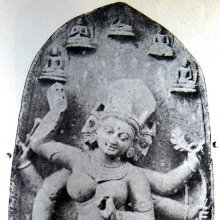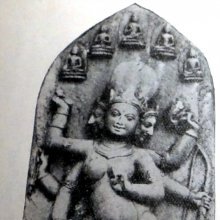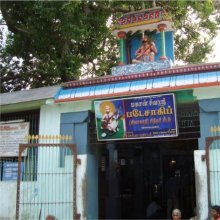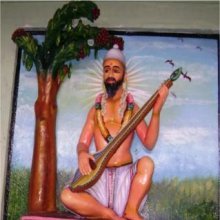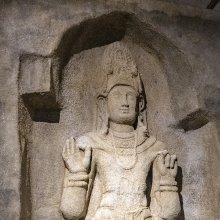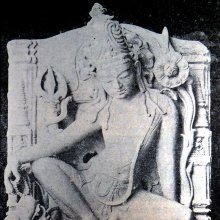Disease: 3 definitions
Introduction:
Disease means something in Hinduism, Sanskrit, the history of ancient India. If you want to know the exact meaning, history, etymology or English translation of this term then check out the descriptions on this page. Add your comment or reference to a book if you want to contribute to this summary article.
Images (photo gallery)
(+17 more images available)
In Hinduism
Natyashastra (theatrics and dramaturgy)
Source: Shodhganga: Elements of Art and Architecture in the Trtiyakhanda of the Visnudharmottarapurana (natya)Walking in Disease is associated with Sthira-gati: one of the various Gatis (“way of walking”) (in Indian Dramas), according to the Viṣṇudharmottarapurāṇa, an ancient Sanskrit text which (being encyclopedic in nature) deals with a variety of cultural topics such as arts, architecture, music, grammar and astronomy.—Sthira-gati denotes the steady movements. To show walking in fever, hunger, disease, tiredness due to penance, dissimulation, excitement, love and sorrow or ease, slow gait should be adopted by the artist. The lover who goes to meet his or her secret lover adopts the sthiragati. In darkness or if a deformed creature is visible or if a person walks a long way, the gait of a person becomes automatically slow down.

Natyashastra (नाट्यशास्त्र, nāṭyaśāstra) refers to both the ancient Indian tradition (shastra) of performing arts, (natya—theatrics, drama, dance, music), as well as the name of a Sanskrit work dealing with these subjects. It also teaches the rules for composing Dramatic plays (nataka), construction and performance of Theater, and Poetic works (kavya).
Yoga (school of philosophy)
Source: ORA: Amanaska (king of all yogas): A Critical Edition and Annotated Translation by Jason BirchDiseases (in Sanskrit: Vyādhi) are destroyed by the Yogic exercises of the Lotus Pose, according to the Dattātreyayogaśāstra verse 35-38ab.—Accordingly, while describing the lotus pose (padmāsana): “Having carefully placed the upturned feet on the thighs and the upturned hands in between the thighs, [the Yogin] should fix the eyes on the tip of the nose. Having lifted the uvula with the tongue; having fixed the chin on the chest and having drawn in the breath slowly according to his capacity, he should fill [the region of] the stomach. After that, he should exhale the breath slowly according to his capacity. This is said to be padmāsana, which destroys all diseases (sarva-vyādhi)”.

Yoga is originally considered a branch of Hindu philosophy (astika), but both ancient and modern Yoga combine the physical, mental and spiritual. Yoga teaches various physical techniques also known as āsanas (postures), used for various purposes (eg., meditation, contemplation, relaxation).
India history and geography
Source: Singhi Jain Series: Ratnaprabha-suri’s Kuvalayamala-katha (history)Diseases (like fever, etc.) represents a scene of human life commonly depicted on the Saṃsāracakra paintings in ancient India, as mentioned in the Kathās (narrative poems) such as Uddyotanasūri in his 8th-century Kuvalayamālā (a Prakrit Campū, similar to Kāvya poetry).—Page 185.21 f.: Here follows a description of a printed scroll illustrating the Jaina conception of saṃsāracakra. [...] The saṃsāra-cakra illustrated the three worlds of hell, human world and the world of gods. [For example:] People suffering from many kinds of diseases like fever, pain and burning, and lying on their cots and meeting their deaths, to gather their mourning servants, wives and friends

The history of India traces the identification of countries, villages, towns and other regions of India, as well as mythology, zoology, royal dynasties, rulers, tribes, local festivities and traditions and regional languages. Ancient India enjoyed religious freedom and encourages the path of Dharma, a concept common to Buddhism, Hinduism, and Jainism.
See also (Relevant definitions)
Query error!
Full-text (+6003): Vyadhin, Roga, Hridroga, Kshudraroga, Shiroroga, Visarpa, Netraroga, Arogya, Meha, Vikara, Aroga, Raktapitta, Kushtha, Amaya, Arshas, Yakshma, Bhagandara, Karnaroga, Ahaka, Agada.
Relevant text
Search found 459 books and stories containing Disease, Diseases; (plurals include: Diseases, Diseaseses). You can also click to the full overview containing English textual excerpts. Below are direct links for the most relevant articles:
International Ayurvedic Medical Journal
NIDANARTHAKAR VYADHI w.r.t CARAK SAMHITA: A REVIEW < [2020, Issue 4, April]
Critical review of shatkriyakala and its significance in management of diseases < [2018, Issue X, October]
Chronic kidney disease -a case study in ayurvedic setting < [2017, Issue I January,]
World Journal of Pharmaceutical Research
A review on orphan drugs- indian perspective < [2023: Volume 12, April issue 5]
Critical review of maha chatushpada adhyaya in charaka samhita < [2022: Volume 11, June issue 7]
Review on impact of climate change on infectious diseases < [2023: Volume 12, December special issue 22]
History of Indian Medicine (and Ayurveda) (by Shree Gulabkunverba Ayurvedic Society)
Chapter 12 - Nosology and the Triumvirate < [Part 6 - The Science of the Triumvirate (Tridosha) Pathogenesis]
Chapter 11 - The Etiological Factors of Disease < [Part 6 - The Science of the Triumvirate (Tridosha) Pathogenesis]
Chapter 9b - Pathological Conditions or Processes in Ayurveda < [Part 6 - The Science of the Triumvirate (Tridosha) Pathogenesis]
Journal of Indian Society of Periodontology
Thesis, antithesis, and synthesis in periodontal and systemic interlink < [Volume 16 (issue 2), Apr-Jun 2012]
Survey on GPs' knowledge and behavior regarding periodontal disease. < [Volume 19 (issue 3), May-Jun 2015]
Awareness of periodontal disease among Aseer school teachers < [Volume 21 (issue 5), Sep-Oct 2017]
Charaka Samhita (English translation) (by Shree Gulabkunverba Ayurvedic Society)
Chapter 8 - The Pathology of Epilepsy (apasmara-nidana) < [Nidanasthana (Nidana Sthana) — Section on Pathology]
Chapter 28 - The Various kinds of Food and Drink (Ashita-Pita) < [Sutrasthana (Sutra Sthana) — General Principles]
Chapter 10 - The (major) Fourfold Basic Factors in Therapeusis (Cikitsa) < [Sutrasthana (Sutra Sthana) — General Principles]
Study of concordance between Mizaj and diseases in NIUM patients. < [Volume 30 (issue 1), Jul-Sep 2010]
Diagnostic methods in ayurveda < [Volume 1 (issue 3), Jan-Mar 1982]
Clinical diagnosis in Ayurveda: Challenges and solutions < [Volume 31 (issue 4), Apr-Jun 2012]
Related products
(+200 more products available)
